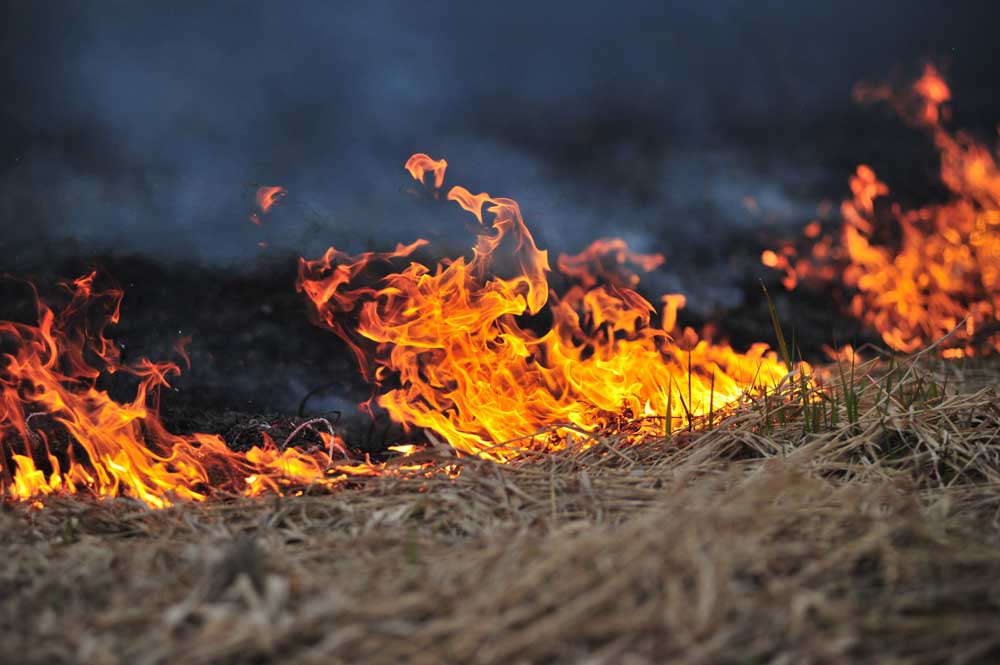Evacuating homeless campers provided extra challenge to those fighting Bessie Butte Fire
Published 12:00 am Saturday, July 28, 2018

- Charred ground remains next to a homeless camp that was evacuated during the Bessie Butte Fire. (Ryan Brennecke/Bulletin photo)
At the very edge of the black scar created by the Bessie Butte Fire, southeast of Bend near China Hat Road, sits a large tent surrounded by haphazard piles of debris, one of a number of homeless camps in this area of the Deschutes National Forest.
This particular site is surrounded by charred pine trees but was largely unharmed by the fire, other than a small hole in the corner of the tent and a drizzle of fire retardant coating some of the supplies. The camp was one of several in the area that first responders from the Deschutes County Sheriff’s Office and U.S. Forest Service visited once the fire erupted, warning campers in the fire’s path to get out while they could.
“Our concern is to save lives, first and foremost,” said Aaron Myers, deputy sheriff with the county sheriff’s office. “With these, you definitely want to get the people out immediately, and worry about property second.”
While wildfire concerns often revolve around homes near the edge of town or in rural subdivisions, the Bessie Butte Fire highlighted an often-forgotten aspect of wildfires: their impact on people living in the forest because they have nowhere else to go. Because of that, it sometimes falls to first responders to track down and notify homeless people if there’s a wildfire heading their way, often with a limited window before the fire reaches them.
All told, fire agencies reached about a dozen residents spread across four or five camps in the area during the Bessie Butte Fire, according to Sgt. William Bailey, a Deschutes County Sheriff’s Office spokesman.
The Bessie Butte Fire started about noon Sunday, about eight miles southeast of Bend. The fire burned about 50 acres before ultimately being corralled by local firefighters, who were able to respond quickly because the fire was close to Bend. The fire was 95 percent contained as of Friday, according to Kassidy Kern, acting public affairs officer for the Deschutes National Forest.
While there was initial concern the fire could threaten homes in Southeast Bend, winds carried it in a different direction, toward China Hat Road and the homeless camps in the area.
David Nieradka, outreach program manager for Central Oregon Veterans Outreach, which works with homeless populations throughout the region, said the portion of the forest near China Hat Road has long attracted transients, but added that more have come to the area in recent years due to rising housing costs across the region.
During weekly trips to deliver food, water and supplies to people living in the area, Nieradka said volunteers with the organization typically run into about a dozen people, but noted that the number of people living there was likely significantly higher. He speculated that homeless people gravitate to the area because they’re less likely to be bothered by authorities than they would be in areas closer to town.
Nathan Garibay, emergency services manager for Deschutes County, said the sheriff’s office evaluates evacuations based on how a fire moves, and the communities located nearby. Garibay said the sheriff’s office was familiar with homeless people camping in the area, and made the decision to evacuate camps near the blaze.
Garibay said evacuating a homeless camp differs significantly from evacuating a town or subdivision. During a community evacuation, residents will receive emergency notifications across multiple platforms, but that may not be an option for the homeless. During the Bessie Butte Fire, officers from the Forest Service and the sheriff’s office went to campsites to let residents know that they need to leave.
In one case, first responders towed a trailer out of the fire’s path, Garibay said.
One challenge is finding the imperiled campsites. While the sheriff’s office is generally aware of areas where homeless people like to camp, Myers said camps can change locations and disappear quickly, making them a challenge to track down.
Additionally, many camps are only accessible by a maze of dirt roads.
Myers added that a lot of people camping in the area leave before first responders can get there, and the ones that remain are typically more than willing to cooperate when asked to leave because of a fire.
“The moment they see smoke, hear sirens, they’re trying to evacuate the area so they don’t become a victim,” he said.
Garibay added that getting people safely out of the path of a wildfire helps firefighters, as well. When there are people in the area, firefighters aren’t able to drop fire retardant to slow the wildfire’s advancement. He said one of the first things fire officials do when fighting a wildfire is shut down nearby roads to the public, which can be more difficult when there are people in the area.
“We don’t want somebody unwittingly rolling in and putting themselves at risk,” Garibay said.
— Reporter: 541-617-7818, shamway@bendbulletin.com








